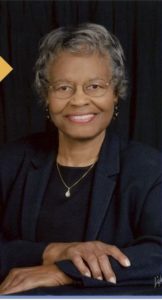
Gladys Mae West
*The birth of Gladys Mae West is celebrated on this date in 1930. She is a Black mathematician and teacher recognized for her contributions to the mathematical modeling of the Earth's shape.
She was born Gladys Mae Brown in Sutherland, Virginia, in Dinwiddie County, rural south of Richmond. Her family was a farming family in a community of sharecroppers. Her mother worked at a tobacco factory, and her father worked for the railroad. Brown realized early on that education would be her way out. At Brown's High School, the top two students of each graduating class received full-ride scholarships to Virginia State College.
Brown graduated in 1948 as valedictorian. Because of their difficulty, she was encouraged to major in science or math, and West ultimately chose to study mathematics. She also became a member of the Alpha Kappa Alpha sorority. Brown graduated in 1952 with a Bachelor of Science in Mathematics. After graduating, she taught math and science for two years in Waverly, Virginia. West then returned to VSU to complete her Master of Mathematics degree, graduating in 1955. Afterward, she taught in Martinsville, Virginia.
In 1956, Brown was hired to work at the Naval Proving Ground in Dahlgren, Virginia, where she became the second Black woman to be hired and one of only four Black employees. She met her husband, Ira West, at the Naval Surface Warfare Center Dahlgren Division, where he worked as a mathematician. They were two of only four black employees at the time. They were married in 1957. They have three children and seven grandchildren.
She was a programmer for large-scale computers and a project manager for data-processing systems that analyze satellite data. Concurrently, West earned a second master's degree in public administration from the University of Oklahoma. In the early 1960s, she participated in an award-winning astronomical study that proved the regularity of Pluto’s motion relative to Neptune, analyzed satellite data, and put together altimeter models of the Earth's shape. She also became the project manager for the Seasat radar altimetry project, the first satellite capable of remotely sensing oceans. West consistently put in extra hours, halting her team's processing time. She was recommended for a commendation in 1979.
From the mid-1970s through the 1980s, West programmed an IBM computer to deliver increasingly precise calculations to model the shape of the Earth – an ellipsoid (a mathematical figure) with irregularities, known as the geoid. Generating an extremely accurate model required her to employ complex algorithms that accounted for variations in gravitational, tidal, and other forces distorting Earth's shape. West's data ultimately became the basis for the Global Positioning System (GPS). 1986 West published Data Processing System Specifications for the Geosat Satellite Radar Altimeter, a 51-page technical report from The Naval Surface Weapons Center (NSWC). The guide was published to explain how to increase the accuracy of estimating geoid heights and vertical deflection, important components of satellite geodesy. This was achieved by processing the data generated by the radio altimeter on the Geosat satellite, which was launched into orbit on March 12, 1984.
West worked at Dahlgren for 42 years, retiring in 1998. After retiring, she completed a Ph.D. in Public Administration from Virginia Tech. West was inducted into the United States Air Force Hall of Fame in 2018, one of the highest honors that Air Force Space Command (AFSPC) bestowed. The AFSPC press release at the time called her one of "the so-called 'Hidden Figures' part of the team who did computing for the US military in the era before electronic systems" – a reference to the 2016 book adapted into the film Hidden Figures.
Capt. Godfrey Weekes, commanding officer at the Naval Surface Warfare Center Dahlgren Division in 2018, described the role played by West in the development of the Global Positioning System: "She rose through the ranks, worked on the satellite geodesy, and contributed to the accuracy of GPS and the measurement of satellite data. As Gladys West started her career as a mathematician at Dahlgren in 1956, she likely had no idea that her work would impact the world for decades to come." West agreed, saying that she had no idea at the time that her work would affect so many: “When you’re working every day, you’re not thinking, 'What impact is this going to have on the world?' You're thinking, 'I've got to get this right.'"
Dr. Gladys West was nominated and won the "Female Alumna of the Year" award at the Historically Black Colleges and Universities Awards sponsored by HBCU Digest in 2018. As of February 2018, West lives in King George's County, Virginia. West prefers using a paper map over a tracking system, saying she still trusts her brain above all. She stated, "I'm a doer, hands-on kind of person. If I can see the road and see where it turns and see where it went, I am more sure."